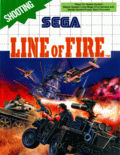
































Line of Fire

Line of Fire is a shooting video game, played from a first person perspective, and developed by Sega. The cabinet features two positional guns, and a design which allows the player(s) to sit down while playing the game. It was first released in arcades in 1989 before being converted to home computers and published by U.S. Gold in 1990. It was released for the Master System in 1991; however, the style of the game was changed to that of an overhead scrolling shooter.
It follows a two-man commando unit as they try to escape from a terrorist facility after seizing a prototype weapon. The arcade game was praised for its graphics but criticised for lacking drama, and the home computer versions were criticized for 'blocky' visuals, though reviewers found that there were some nice touches. The Sega Master System version was seen as disappointing.
The game sees the player placed a member of a two-man commando team who have been charged with going behind enemy lines to bring down a terrorist organisation which has access to a large arsenal of weaponry. During the mission the team find a 'special weapon', which is a vehicle mounted, automatic machine pistol, and must report their findings. However, the player is faced with many enemy troops and military vehicles which need to be destroyed in order for the commando squad to escape in the jeep, and must use the 'special weapon' against the terrorists.
The game is played from a first person perspective, with two cabinet mounted, positional guns used the shoot enemies on the screen. There are eight stages which take place in various settings including the enemy base, jungle, desert and ruins. At the end of each is a boss vehicle which must be destroyed to progress. Ammunition is limited to a few clips of bullets for the machine gun, a small supply of hand grenades and a screen clearing missile, although additional supplies can be obtained by shooting the relevant icon when they appear during play.
The stages scroll both horizontally and into the screen is pseudo-3D, and due to Sega's dedicated sprite handling software the game was able to combine the two movements in a single stage, effectively turning corners. This revolutionary system allowed the player to experience a real 3D landscape. Between stages a map screen is displayed which shows the player progressing through the terrorist facility and towards freedom.
The Line of Fire arcade machine uses the Sega X Board hardware, comprising two Motorola 68000 processors running at 12.5Mhz as its CPU, and sound is reproduced using a Yamaha YM2151 sound chip. It features Raster graphics at a resolution of 320 x 224 pixels on a horizontally orientated monitor. There are two different cabinets available for the game. One cabinet allows the player(s) to sit down as they are playing the game, reaching forward to use the cabinet mounted light guns. The other is an upright cabinet with attached light guns.
U.S. Gold acquired the licence to release the game on home computers, and versions were produced for the Amiga, Amstrad CPC, Atari ST, Commodore 64 and ZX Spectrum. The conversion for all five home computers was handled by Creative Materials and all were released in 1990. For these versions there is no light gun support, instead the player moves a crosshair using a mouse, joystick or keyboard to target enemies, and pressing a button to fire.
A version was created for the Sega Master System in 1991, published by Sega and developed by Sanritsu Denki. This version is very different from every other conversion as it is an overhead vertically scrolling shooter, although the storyline and locations are mostly unchanged. The game does not feature light gun support, the player using the standard control pad. This game also features support for the SegaScope 3-D Glasses, a way of viewing the game in 3D, if the player enters a button combination when starting up the console with the Line of Fire cartridge inserted.
How to play:
Click on the joystick icon in the Line of Fire online emulator to see how to control the Line of Fire game









































Comments